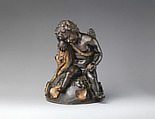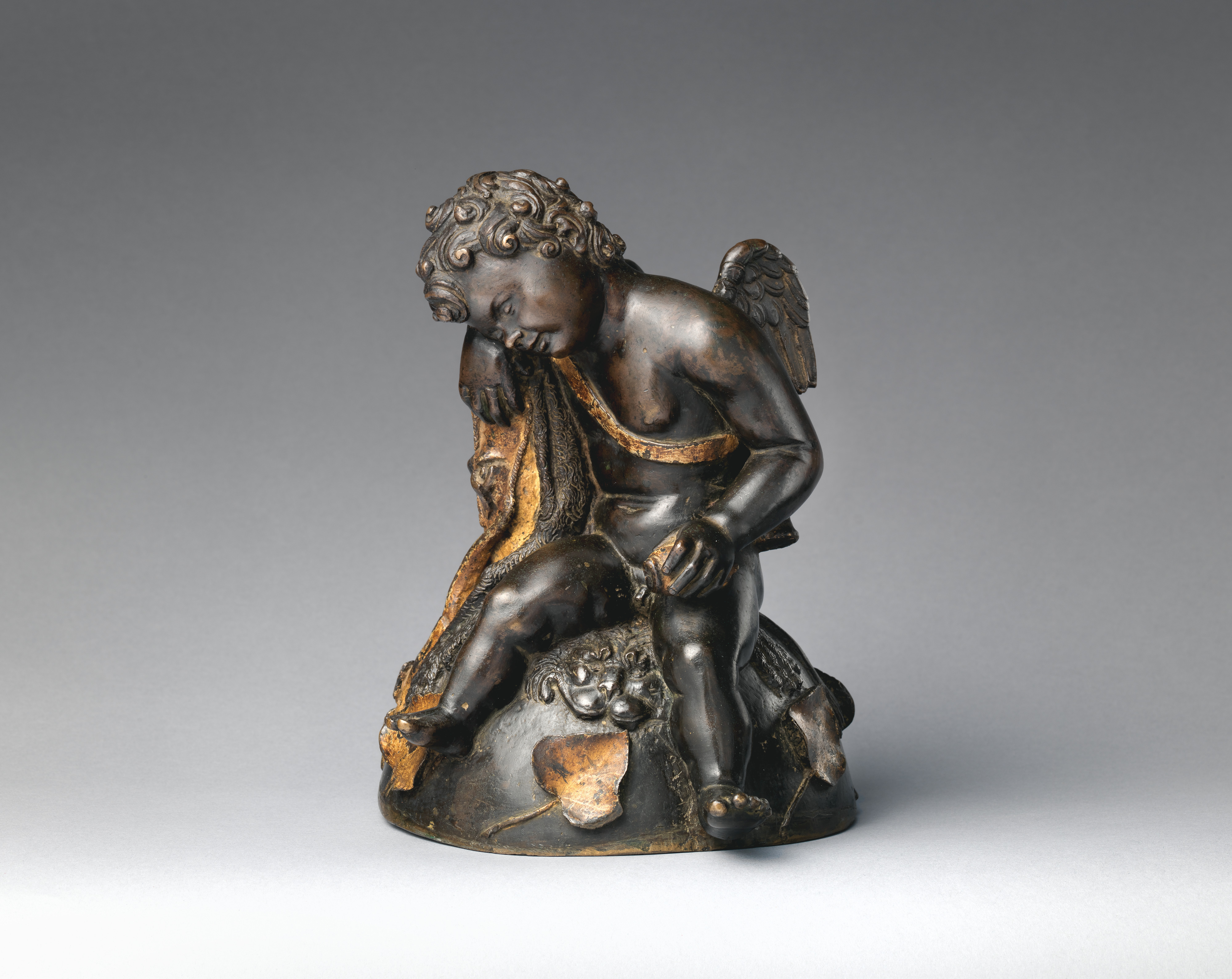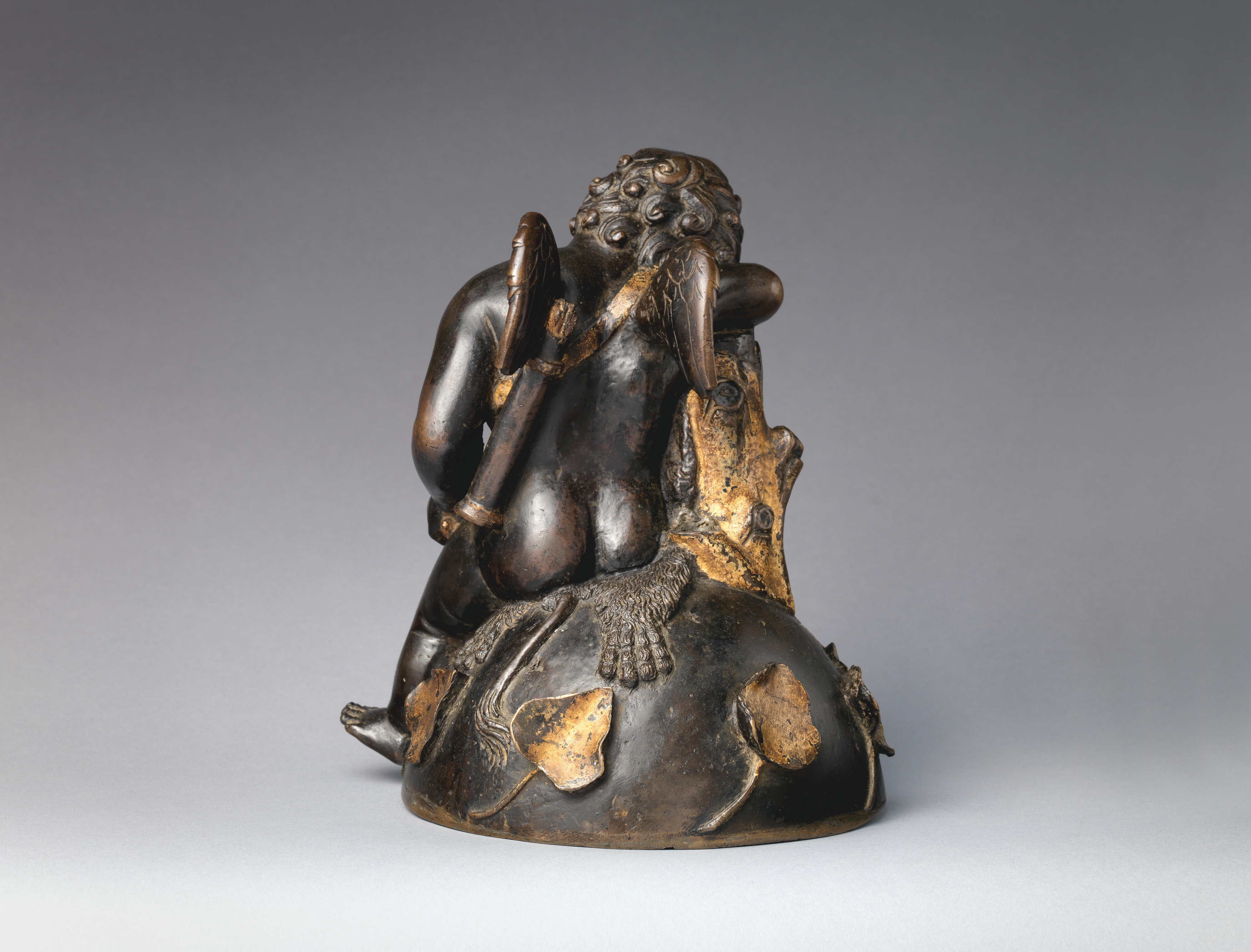Sleeping Cupid
Not on view
Leaning against the stump of a tree, his body cushioned by a lionskin, Cupid sits astride a hemispheric orb decorated with foliage. The figure is asleep, and his heavy head rests on his right arm, his closed eyelids dotting a peaceful mien. Still, an alertness belies Cupid’s restful pose. His back is erect, and his left hand grasps a shell. He wears his quiver, and his wings appear at the ready. Gilding adorns several elements of the composition: the leaves, the undone bow, the tree stump, the quiver, and the shell.
The Sleeping Cupid, the mischievous god of desire at peace and disarmed, was a well-known subject since antiquity that gained renewed popularity in the Renaissance.[1] One catalyst for the reinvigorated interest was Michelangelo’s now-lost marble Sleeping Cupid, begun in the late 1490s.[2] Acclaimed for having matched and even surpassed the ancients, the marble entered the collection of Isabella d’Este by 1502 where it was shown alongside a version of the subject ascribed to Praxiteles.[3] Like the present bronze, Michelangelo’s marble and many of its derivatives presented Cupid resting on a lionskin, referencing his competition with Hercules.
In nearly all examples of the theme, in sculpture or painting, Cupid is shown lying on his back or side.[4] The Sleeping Cupid resting upright is extremely unusual, and was likely conceived in relation to the bronze’s function and placement. The nearest precedent for the pose is a well-known northern Italian medal of the Sleeping Cupid that circulated widely and exists in at least sixty copies (fig. 54a).[5] The medal shows the figure draped against a chest containing his quivers.
No other versions of the present bronze are known. Since its publication by Leo Planiscig in 1932, the Sleeping Cupid has rightfully been considered Venetian in origin. Planiscig dated the work, then in the Bruno Kern collection in Vienna, to the end of the quattrocento and proposed an affinity between it and a bronze young Bacchus astride a medal in the Louvre.[6] Hans Weihrauch confirmed a date of around 1500. Wendy Stedman Sheard pushed the dating into the early decades of the sixteenth century and linked the work to the circle of Antonio Lombardo by virtue of comparing the child’s stylized curls to bronzes associated with that artist. Images of sleeping figures, including those of Venus or the Christ Child, began appearing with great frequency in Venice around 1500; this figure fits well within that milieu.[7]
Our Cupid likely formed part of a fountain apparatus, as first observed by Planiscig. Visible channels in the hemisphere’s hollow underside indicate that a stream flowed from the shell, suggesting that the work was meant for a tabletop arrangement where it surmounted a basin that collected the water. Recent technical analysis confirms Planiscig’s basic thesis as to the bronze’s function, while also providing new insights.[8] Evidence points to water emanating from at least two separate locations: the shell and Cupid’s genitals. Both contain tiny cast-in tubes, likely composed of copper. Additionally, the tree stump, which has a large opening at the top and traces of lead solder, possibly connected to a now-lost bronze element, perhaps a tree, that may have included another jet (or jets) of water.
Thus the fountain would have presented an unusual iconography of a sleeping, peeing Cupid, a crude visual joke that references and subverts traditional representations of the Sleeping Cupid and the putto mictans.[9] A seventeenth-century drawing in the Royal Collection records four Cupid sculptures: three recline (at least one likely a record of the lost Michelangelo) and one sits atop a rocky formation, hand at his genitals (fig. 54b).[10] This last Cupid is alert rather than sleeping, but suggests in spirit and pose the present bronze, whose conceit has few, if any, comparanda. The multiple, crisscrossing jets would surely have provided an amusing spectacle, undercutting traditional associations of sleep with peace, disarmament, or even death. The creeping vines may even allude to Dionysian excess, and the cascading jet issuing from the genitals a sign of alcohol’s disinhibiting effect even in slumber.
The weight of the bronze indicates that, rather than having been created for a tabletop, the work was probably part of a large freestanding fountain—perhaps one similar to that seen in Jan van Eyck’s Madonna at the Fountain (1439)[11]—and intended for the courtyard of a Venetian palazzo. Horizontal scribe lines and traces of lead solder around the lower edge of the half sphere point toward its being originally joined to another half sphere. The Sleeping Cupid would not be unlike other bronzes that comprised elements in Renaissance fountains, including Verrocchio’s Putto with a Dolphin for a fountain at the Villa Medici in Careggi.[12] Though our bronze exhibits fine detail work executed in the wax, particularly the lion pelt, the wings are far less precisely delineated, suggesting that the intended site or other elements of the fountain arrangement would have obstructed their view.
The bronze’s ownership history before it appeared in the 1931 auction of objects from the Stroganov collection is unknown.[13] The Stroganovs, one of the richest and most powerful Russian dynasties, amassed an opulent collection of paintings, sculpture, and decorative art from around the globe, the bulk of which are today in the Hermitage. The Sleeping Cupid may have been acquired during any one of the family members’ collecting trips to Italy throughout the eighteenth and nineteenth centuries.
-JF
Footnotes
(For key to shortened references see bibliography in Allen, Italian Renaissance and Baroque Bronzes in The Metropolitan Museum of Art. NY: The Metropolitan Museum of Art, 2022.)
1. I am grateful to Rebecca Arnheim for her research on the bronze, which has aided in the writing of this entry. For the Sleeping Cupid, see Campbell 2004, pp. 87–113.
2. See Bambach 2017, pp. 62, 321 n. 186, with previous references.
3. See Fusco and Corti 2006, pp. 41–52.
4. See, for example, the ancient Greek Eros Sleeping, MMA, 43.11.4. For examples in painting, see Tintoretto’s Vulcan Surprising Venus and Mars, ca. 1555, Alte Pinakothek, Munich (9257), which likely records Michelangelo’s lost sculpture. The subject continued to enjoy popularity in the seventeenth century; see Caravaggio’s Sleeping Cupid, 1608, Palazzo Pitti, Florence (Pal. 1912 no. 183).
5. The medal was formerly attributed to a Pseudo Francesco Antonio da Brescia and identified in Lewis 2008, pp. 130–31, as the Vicentine Master.
6. Planiscig 1932a, p. 745.
7. Meiss 1966.
8. I am grateful to Linda Borsch for her close study of the bronze (ESDA/OF, March 21, 2019) and the conclusions she shared with me.
9. On the type, see Simons 2009 and Coonin 2013.
10. For the drawing, see Fusco and Corti 2006, pp. 50–52.
11. Koninklijk Museum voor Schone Kunsten, Antwerp, 411.
12. Museo di Palazzo Vecchio, Florence; see Butterfield 1997, p. 127.
Due to rights restrictions, this image cannot be enlarged, viewed at full screen, or downloaded.
This artwork is meant to be viewed from right to left. Scroll left to view more.




